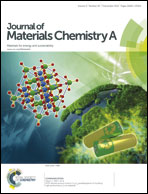Shell-thickness dependent electron transfer and relaxation in type-II core–shell CdS/TiO2 structures with optimized photoelectrochemical performance
Abstract
Core–shell CdS/TiO2 structures are promising for solar-to-fuel conversion applications because their ideal type-II band alignment helps effective charge transfer to form the CdS+/TiO2− system. A better understanding of the charge carrier dynamics is critical to provide guiding principles for designing photoelectrochemical (PEC) devices. Hence, TiO2 shell-thickness dependent charge carrier dynamics and competition between electron relaxation in CdS (e.g. recombination and trapping) and electron transfer from CdS to TiO2 were investigated using ultrafast transient absorption (TA) spectroscopy. The results indicate that the CdS/TiO2 nanocomposite with a molar ratio of 2 : 1 exhibits the highest electron transfer rate constant of ![[k with combining macron]](https://www.rsc.org/images/entities/i_char_006b_0304.gif) ET = 2.71 × 1010 s−1, along with an electron relaxation rate of
ET = 2.71 × 1010 s−1, along with an electron relaxation rate of ![[k with combining macron]](https://www.rsc.org/images/entities/i_char_006b_0304.gif) CdS/TiO2 = 3.43 × 1010 s−1, resulting in an electron transfer quantum efficiency of QET = 79%, which also corresponds to the best PEC hydrogen generation in the CdS/TiO2 core–shell composites. However, the electron transfer rate decreases with increasing thickness of the TiO2 shell consisting of aggregated nanoparticles. One possible explanation is that the CdS and TiO2 form relatively larger, separate particles, or less conforming small particles, with poor interfaces with increasing TiO2, thereby reducing electron transfer from CdS to TiO2, which is supported by SEM, and TEM data and consistent with PEC results. The thickness and morphology dependence of electron transfer and relaxation provides new insight into the charge carrier dynamics in such composite structures, which is important for optimizing the efficiency of PEC for solar fuel generation applications.
CdS/TiO2 = 3.43 × 1010 s−1, resulting in an electron transfer quantum efficiency of QET = 79%, which also corresponds to the best PEC hydrogen generation in the CdS/TiO2 core–shell composites. However, the electron transfer rate decreases with increasing thickness of the TiO2 shell consisting of aggregated nanoparticles. One possible explanation is that the CdS and TiO2 form relatively larger, separate particles, or less conforming small particles, with poor interfaces with increasing TiO2, thereby reducing electron transfer from CdS to TiO2, which is supported by SEM, and TEM data and consistent with PEC results. The thickness and morphology dependence of electron transfer and relaxation provides new insight into the charge carrier dynamics in such composite structures, which is important for optimizing the efficiency of PEC for solar fuel generation applications.


 Please wait while we load your content...
Please wait while we load your content...